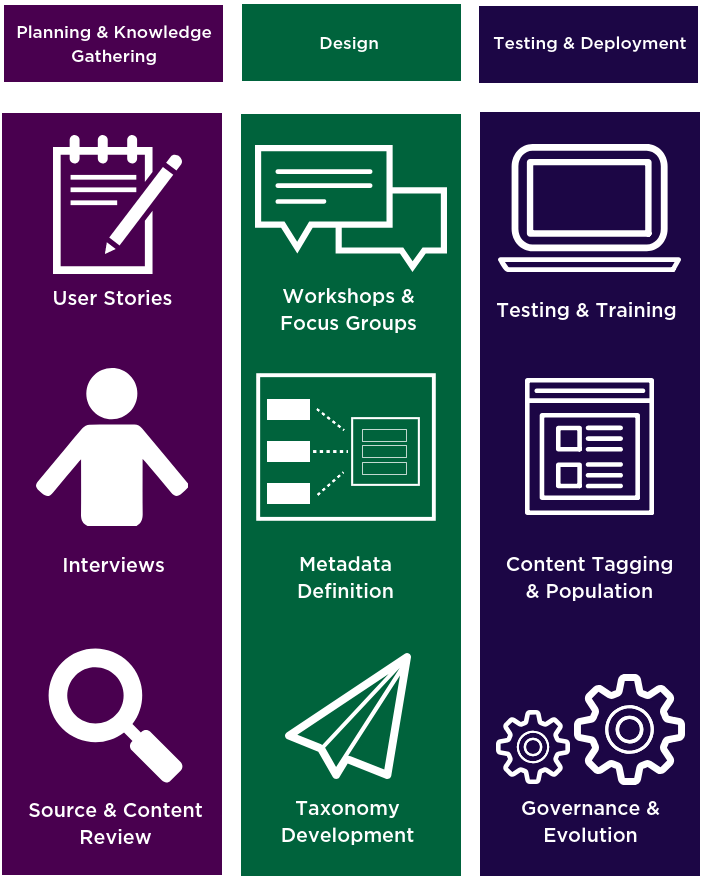We have all heard about the exponential growth of electronic information/data/content in recent years and been warned about the impending boom of data and information growth in the near future. Industry research has told us that the time spent looking for and not finding information costs an organization a total of $6 million a year (Feldman 2004). The cost of reworking information because it hasn’t been found costs a further $12 million a year (15% of time spent in duplicating existing information) (Feldman 2004). While these numbers are shocking and have spurred many content management projects, the implications for legal departments and firms are just as drastic.
Due to the increase of stored electronic information, the discovery process for legal matters has increased in cost. Gibson Dunn research indicates that “22% of smaller companies are likely to run a discovery process once a month or more, whilst 20% of the largest organizations have 10 or more cases a month.” And that a “third of [survey] respondents have been challenged in the past over the completeness of their electronic information, both in court and with regulatory authorities” (Gibson Dunn 2014). Not only are knowledge workers unable to find relevant content, but the hours spent finding content have translated into higher legal costs.
So what can organizations do to address the findability problem? They can adopt the concept of “manage-in-place,” which is the process of implementing centralized indexing, retention and hold policies across multiple enterprise applications and repositories, without migrating them to a dedicated archive (Gibson Dunn 2014). In order to successfully manage content in this way, we first need a framework to describe the content and drive the ability to index and surface content through centralized search and discovery. This is where taxonomies and metadata can add measurable value. If we are asked to provide all content related to a specific matter, we will need to search across multiple applications. Therefore, the content needs to be tagged consistently and accurately. Simple and straightforward, right?
Unfortunately not. We have found that our clients struggle to consistently and appropriately tag content because they lack a taxonomy that sufficiently and accurately describes their actual content. Most often, taxonomies are derived from a top-down approach while ignoring bottom-up or vice versa. Or, the taxonomy design effort is not scalable and capable of describing all enterprise content. As a result, when they need to locate a specific set of documents or content related to a topic, it requires many hours of searching and many individuals from across the enterprise to assist. The associated costs can be largely avoided through the development of a taxonomy that accounts for actual, existing content through targeted, usable metadata fields.
EK can help you to design and implement a business taxonomy that accurately and concisely describes all your content through our Business Taxonomy Design Methodology (seen below) and proven results. Our Business Taxonomy Design Methodology ensures the resulting business taxonomy is expressive and usable through the inclusion of user focused activities such as interviews, user stories, and workshops.
A business taxonomy is designed for usability and findability of content, allowing end users the ability to browse intuitively as well as search for specific content as opposed to a traditional taxonomy designed for classification. The business taxonomy can also be leveraged to support large scale searches of an enterprise’s content by providing metadata such as subject, topic, project, and more specific fields as parameters and reducing the burden of time and inefficient discovery.
By leveraging a business taxonomy to not only support findability for end users, but also to support eDiscovery and records management efforts, an organization stands to reap the benefits of reduced risks and cost avoidance. Business users of intranets or content repositories who are able to search and locate content using an intuitive taxonomy and metadata framework experience measurable time savings and productivity increases. When the same business taxonomy is optimized and integrated with an eDiscovery application, legal teams will experience similar results and spend less time gathering content to place on litigation hold or disclose. Specifically, designing and implementing a business taxonomy will have the following effects:
- Avoid costs related to the effort of finding and collocating content in preparation for litigation by knowing or being able to find all content related to a topic or case quickly. (ARMA 2010)
- Reduce the risk of accidental release or deletion through improved content and records management.
- Reduce the risk of spoliation by having less unknown data that could be overlooked when instituting a litigation hold or collecting documents to disclose. (ARMA 2010)
Once the taxonomy design is complete, consider implementing an enterprise search tool that will leverage the taxonomy and make content more findable and discoverable. If this something you’d like to speak with the experts at EK about, contact us at info@enterprise-knowledge.com.
References
ARMA. “Litigation Costs: A 1,000:1 Ratio” December 2010
Feldman, S. “The High Cost of Not Finding Information.” March 2004
Gibson Dunn. “2013 Year-end Electronic Discovery and Information Law Update.”
January 2014

